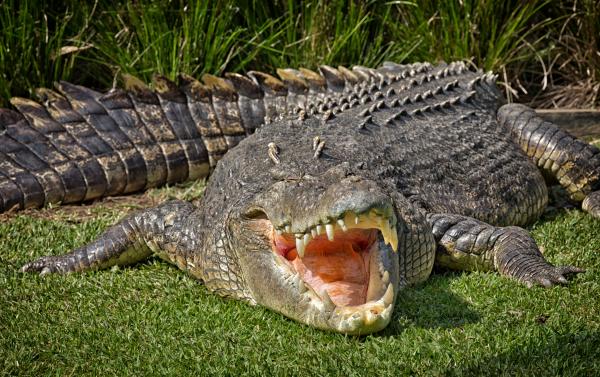Alligator vs. Crocodile vs. Caiman – Welcome to the fascinating world of reptiles, where even the most experienced wildlife enthusiasts can get confused between different species. Today, we’re going to talk about the notorious trio of alligators, crocodiles, and caimans – three creatures that are often mistaken for one another, despite their distinctive features.
First things first: let’s get one thing straight – they may all look similar, but they are not even from the same family! While they belong to the broader classification of Crocodylia, they are from different subfamilies – alligators are from the family Alligatoridae, crocodiles are from the family Crocodylidae, and caimans are from the family Alligatoridae (subfamily Caimaninae).
Now, let’s talk about the appearance of Alligator vs. Crocodile vs. Caiman. Alligators have a wider snout compared to crocodiles, and their teeth are less visible when their mouth is closed. Crocodiles, on the other hand, have narrow snout and visible teeth even when their mouth is shut. Caimans are often confused with alligators due to their similar appearance, but they have a more V-shaped snout and a bony ridge above their eyes.
Apart from their physical appearance, alligators, crocodiles, and caimans have distinct behavioral characteristics. For example, alligators are known to be more docile and tend to inhabit freshwater environments, while crocodiles are more aggressive and can survive in both freshwater and saltwater environments. Caimans, on the other hand, are found primarily in Central and South America and are known for their aggressive behavior and powerful bite.
How to Identify an Alligator?
Alligators are fascinating reptiles that are found primarily in the southeastern United States. They are classified as part of the family Alligatoridae and are one of two species of alligator, the other being the Chinese alligator. Alligators are cold-blooded creatures that can grow up to 14 feet in length and weigh over 1,000 pounds. They are characterized by their wide, U-shaped snout, which is ideal for catching prey in freshwater environments. Alligators have a full set of sharp teeth that are perfect for crunching through tough turtle shells or fish bones. Their skin is also a notable feature, with rough, bumpy scales that help protect them from predators.
So, how do you identify an alligator? The first thing to look for is the snout. Alligators have a wide, U-shaped snout that sets them apart from their narrow-snouted cousins, the crocodiles. A snout is an important tool for identifying the type of prey a reptile feeds on. Alligators use their snouts to crush and tear apart their prey, while crocodiles use their long, pointed snouts to snatch up faster-moving prey like fish and birds.
Another key feature to look for is the teeth. Alligators have an impressive set of sharp teeth that are visible when their jaws are open. However, when their mouths are closed, only the fourth tooth on each side of the lower jaw is visible. This is because the rest of the teeth are hidden inside the jawbone. Crocodiles, on the other hand, have visible teeth in both the upper and lower jaws, which makes them look more menacing.
Lastly, pay attention to the color and pattern of the skin. Alligators have a dark, blackish-gray skin color that is covered in bumpy, rough scales. Their skin helps protect them from predators and also helps them blend into their surroundings. This is especially important when they are hunting or hiding from potential threats

How to Identify a Crocodile?
Crocodiles are magnificent reptiles that are found in many parts of the world, including Africa, Australia, and South America. They are classified as part of the family Crocodylidae and are known for their long, narrow snouts and powerful jaws. Crocodiles are cold-blooded creatures that can grow up to 23 feet in length and weigh over 2,000 pounds. They are apex predators and feed on a variety of animals, including fish, birds, and mammals.
One of the most notable features of crocodiles is their long, narrow snout. Unlike alligators, which have a wide, U-shaped snout, crocodiles have a narrow, V-shaped snout. This snout is an adaptation that allows them to catch faster-moving prey like gazelles and antelopes. Crocodiles also have visible teeth in both their upper and lower jaws, which makes them look more menacing than alligators.
Another feature that sets crocodiles apart is their skin. Crocodile skin is smooth and covered in small, raised bumps called scutes. These scutes help protect the crocodile’s skin from abrasions and injuries. Some species, like the saltwater crocodile, have a gray-green skin color that helps them blend into their watery surroundings, while others, like the Nile crocodile, have a darker, brownish-gray skin color.
Crocodiles also have a unique set of sensory organs on their heads called integumentary sensory organs. These organs are highly sensitive and allow the crocodile to detect changes in pressure and movement in the water. They are especially useful for hunting, as they help the crocodile locate prey even in murky water.

How to Identify a Caiman?
Caimans are the underdog of the crocodilian world. Often overlooked in favor of their bigger and more famous cousins, the alligator and crocodile, caimans are a unique and fascinating species in their own right. They are found in Central and South America and are part of the family Alligatoridae, which they share with alligators. Despite their similarities, there are a few key features that set caimans apart.
The first thing to look for when trying to identify a caiman is its size. Caimans are significantly smaller than alligators and crocodiles, usually only growing up to around 6 feet in length. This makes them easier to miss in the wild, but also less of a threat to humans.
Another feature to look for is their snout. Like alligators, caimans have a wide, U-shaped snout, but it is much shorter and stubbier. This gives them a somewhat comical appearance like they are perpetually smirking. Their teeth are also notable, with sharp, interlocking teeth that are perfect for holding onto slippery prey.
Caimans also have distinctive bony ridges or bumps, called osteoderms, on their backs that run parallel to their spine. These ridges provide additional protection to the caiman’s back and make them more difficult for predators to take down.
The color and pattern of a caiman’s skin can vary depending on the species and habitat. Some species, like the spectacled caiman, have a black and yellow pattern around their eyes that resembles glasses, giving them a distinctive look. Others, like the yacare caiman, have a brownish-green color that helps them blend into their surroundings.

Alligator vs. Crocodile vs. Caiman-Key differences:
Alligators vs. crocodiles vs. caimans are three of the most well-known reptiles in the world. While they are often confused for one another, they are actually quite different in several key ways.
Taxonomic Differences: Alligators and caimans are part of the family Alligatoridae, while crocodiles are part of the family Crocodylidae. This means that they are not only different species, but they are not even from the same family.
Size: Crocodiles are the largest of the three reptiles, with some species reaching lengths of over 23 feet and weighing over 2,000 pounds. Alligators and caimans, on the other hand, are smaller, with the largest species of alligator, the American alligator, reaching lengths of up to 14 feet and weighing up to 1,000 pounds.
Skull and Snout Shape: One of the easiest ways to differentiate between alligators, crocodiles, and caimans is by looking at their skull and snout shapes. Alligators have a wide, U-shaped snout, while crocodiles have a narrow, V-shaped snout. Caimans, on the other hand, have a snout that is more similar in shape to an alligator, but shorter and stubbier.
Color: The color and pattern of their skin can also vary between the three reptiles. Crocodiles tend to have a lighter color and a more uniform pattern, while alligators and caimans tend to have darker colors and more varied patterns.
Speed: Crocodiles are known for their impressive speed, with some species able to reach speeds of up to 30 miles per hour in short bursts. Alligators and caimans, while still fast, are not quite as speedy as crocodiles.
Behavior: Alligators are typically less aggressive than crocodiles and caimans, with a tendency to shy away from human interaction. Crocodiles and caimans, on the other hand, can be much more aggressive and territorial.
Diet: Alligators, crocodiles, and caimans are all carnivores, but their diets can vary depending on their natural habitat. Alligators tend to feed on fish and small mammals, while crocodiles are known for feeding on larger mammals like wildebeest and zebras. Caimans, meanwhile, tend to feed on smaller prey like fish and insects.
Aggression: Crocodiles and caimans are generally considered to be more aggressive than alligators, with a tendency to attack humans who get too close to their territory. Alligators are typically less aggressive, but still have the potential to attack if they feel threatened.
Strength: Alligators, crocodiles, and caimans are all incredibly strong animals, with the ability to take down prey many times their own size. However, crocodiles are considered to be the strongest of the three, with a bite force of over 3,000 pounds per square inch.
Lifespan: Alligators and crocodiles can live up to 70 years in the wild, while caimans typically have a shorter lifespan of around 30 years.
Natural Habitat: Alligators are found in the southeastern United States, while crocodiles are found in Africa, Australia, and parts of Asia. Caimans are found in Central and South America.
Wrapping Up
In conclusion, while alligators vs. crocodiles vs. caimans may look similar at first glance, they are actually quite different in several key ways. From their taxonomic differences to their size, skull, and snout shape, color, speed, behavior, diet, aggression, strength, lifespan, and natural habitat, each reptile has its own unique set of characteristics that makes them different in its own way.
Not that you will ever encounter all three of them together at the same place but even if you do, I hope the knowledge from this article will come in handy.
Frequently Asked Questions (FAQs):
What is the main difference between alligators, crocodiles, and caimans?
Alligators and caimans are part of the family Alligatoridae, while crocodiles are part of the family Crocodylidae. This means that they are not only different species, but they are not even from the same family.
How can you identify an alligator?
Alligators have a wide, U-shaped snout and tend to have darker colors and more varied patterns.
How can you identify a crocodile?
Crocodiles have a narrow, V-shaped snout and tend to have a lighter color and a more uniform pattern.
How can you identify a caiman?
Caimans have a snout that is more similar in shape to an alligator, but shorter and stubbier.
Which one is more aggressive, alligator vs. crocodile vs. caiman?
Crocodiles and caimans are generally considered to be more aggressive than alligators, with a tendency to attack humans who get too close to their territory. Alligators are typically less aggressive, but still, have the potential to attack if they feel threatened

















